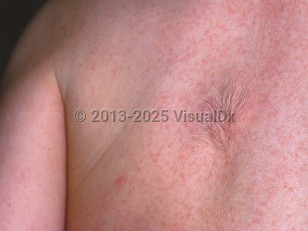Fibrous hamartoma of infancy
Alerts and Notices
Important News & Links
Synopsis

Fibrous hamartoma of infancy is a rare, benign, hamartomatous soft tissue tumor that appears within the first 2 years of life. It presents as a painless solitary nodule, tumor, or plaque that is commonly located on the trunk or arms, especially in the axillary, shoulder, or pubic region. Male infants are affected more frequently than female infants.
Fibrous hamartoma may be congenital, and most reported cases were noted in the first year of life. Slow growth up to the age of 5 years is typical, and a few cases have shown spontaneous regression. Rarely, multiple lesions are present.
In a recent study of 145 cases, 2 cases were found to have sarcomatous features histopathologically. The clinical significance of this phenomenon is not yet clear.
Fibrous hamartoma may be congenital, and most reported cases were noted in the first year of life. Slow growth up to the age of 5 years is typical, and a few cases have shown spontaneous regression. Rarely, multiple lesions are present.
In a recent study of 145 cases, 2 cases were found to have sarcomatous features histopathologically. The clinical significance of this phenomenon is not yet clear.
Codes
ICD10CM:
D21.9 – Benign neoplasm of connective and other soft tissue, unspecified
SNOMEDCT:
56364004 – Fibrous hamartoma of infancy
D21.9 – Benign neoplasm of connective and other soft tissue, unspecified
SNOMEDCT:
56364004 – Fibrous hamartoma of infancy
Look For
Subscription Required
Diagnostic Pearls
Subscription Required
Differential Diagnosis & Pitfalls

To perform a comparison, select diagnoses from the classic differential
Subscription Required
Best Tests
Subscription Required
Management Pearls
Subscription Required
Therapy
Subscription Required
References
Subscription Required
Last Reviewed:01/25/2021
Last Updated:10/09/2022
Last Updated:10/09/2022
Fibrous hamartoma of infancy

